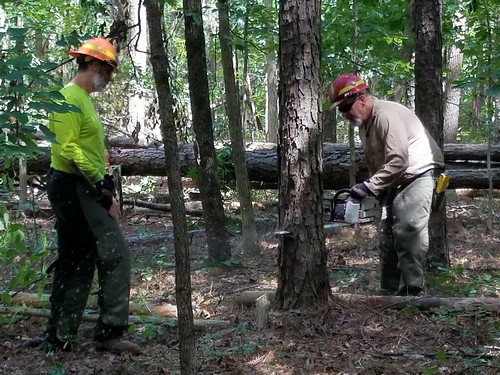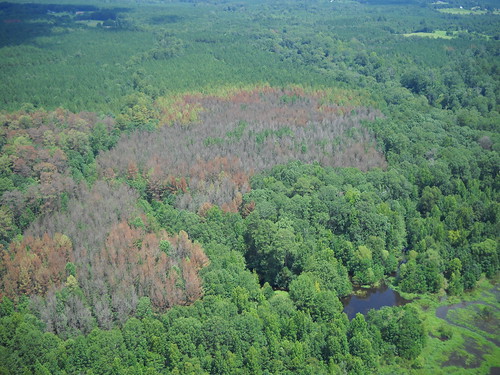
Forest restoration crews in Mississippi are directing a full-frontal assault at eliminating the southern pine beetle, an insect the size of a grain of rice, that are threatening to destroy tens of thousands of acres of pine stands on four U.S. Forest Service ranger districts and nearby private forests.
Forest health officials have classified the level of infestation as a severe outbreak. “This outbreak is unprecedented in scope with beetle activity progressing at breakneck speed with infestations rapidly escalating in size, coalescing and decimating whole plantations,” said Jim Meeker, an entomologist with the Forest Service.
Recent southern pine beetle surveys conducted by air and on the ground found more than 3,500 spots of infestation located on the Homochitto Ranger District in southwest Mississippi; Bienville Ranger District in central Mississippi; Tombigbee Ranger District and the Holly Springs Ranger District both in northern Mississippi.
To manage an outbreak, foresters generally use one of two suppression methods of either cut and remove or cut and leave. Cutting trees helps prevent spot growth by disrupting the beetle pheromone communication system and thus their ability to effectively aggregate and mass attack new pine trees. It is generally thought that most southern pine beetles die before they can colonize trees in a new spot, particularly in the summer when survival outside of the tree is short.
The southern pine beetle is a cyclical outbreak species. During an outbreak it becomes an aggressive tree-killer with broad impacts across multiple forests--privately owned land and public land alike.
Public awareness about the beetle is a role shared by the national forest staff and the Mississippi Forestry Commission. “We are working with and reaching out to private landowners who have questions or need assistance related to the southern pine beetle outbreaks,” Mississippi State Forester Charlie Morgan said.
Historically, the southern pine beetle has proved to be the most destructive forest pest in the South, both in economic and ecological impacts. According to the U.S. Forest Service Southern Research Station, during the 28 years for which they have data, estimates of short-run impacts indicate that timber producers have lost about $1.2 billion to the southern pine beetle, or about $43 million per year.
In the absence of southern pine beetle suppression, large-scale pine mortality occurs, which destroys endangered species habitat, threatens recreation, infects timber and reduces property values. Given the rate of infestation, the Forest Service estimates a potential loss of as much as 25,000 acres of pine stands in Mississippi.
In Mississippi, an incident management team is charged with suppressing the outbreak with manual labor, aggressively cutting the damaged trees. This summer, suppression workers have been challenged by pop-up showers and saturated soil. Because of the cumulative amount and frequency of rain, logging crews have limited ability to operate heavy equipment.
Forest officials say crews will continue to persevere through weather events and rigorous terrain, inspired by the importance of their work to the state, landowners and the communities surrounding the forest.

